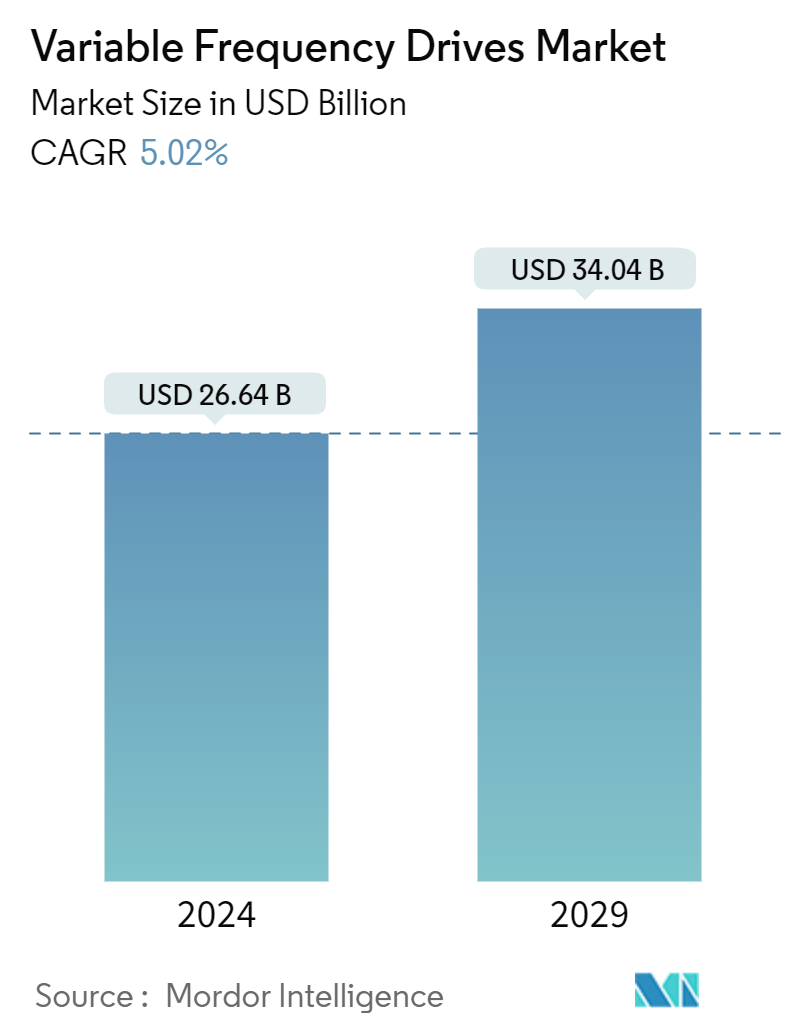Market Size of Variable Frequency Drives Industry

| Study Period | 2019 - 2029 |
| Market Size (2024) | USD 26.64 Billion |
| Market Size (2029) | USD 34.04 Billion |
| CAGR (2024 - 2029) | 5.02 % |
| Fastest Growing Market | Asia Pacific |
| Largest Market | Asia Pacific |
| Market Concentration | High |
Major Players
*Disclaimer: Major Players sorted in no particular order |
Variable Frequency Drives Market Analysis
The Variable Frequency Drives Market size is estimated at USD 26.64 billion in 2024, and is expected to reach USD 34.04 billion by 2029, growing at a CAGR of 5.02% during the forecast period (2024-2029).
- Rapid Industrialization Driving VFD Adoption Across Industries:The Variable Frequency Drives (VFD) market is witnessing accelerated growth due to rapid industrialization, especially in emerging economies. For example, China's industrial production surged by 9.6% in 2021, and the country aims to produce 35 million automotive units by 2025. This expansion is creating significant opportunities for VFD deployment across various sectors. The rise of automation in manufacturing is further boosting the market, with the International Federation of Robotics predicting that global industrial robot installations will increase to 518,000 units by 2024.
- Automation driving growth: Smart manufacturing initiatives such as India’s SAMARTH Udyog Bharat 4.0 are raising awareness of Industry 4.0, which in turn is increasing automation adoption.
- Emerging industries: VFDs are increasingly being used in new applications, such as carbon capture and hydrogen generation, broadening their reach.
- Government support: Collaborations between VFD manufacturers and government agencies are accelerating market expansion, as seen in Danfoss’ partnership with Kolkata and Chennai Metro Rail projects.
- Energy Efficiency: A Key Driver for VFD Market Growth:The growing emphasis on energy efficiency is another critical driver of VFD market growth. According to the International Energy Agency, electric motors consume nearly 40% of the energy used in power industries. VFDs enhance energy efficiency, particularly when paired with motors in variable torque load applications like pumps and fans. By adjusting motor speed, VFDs can significantly reduce energy consumption.
- Energy-saving potential: ABB’s whitepaper suggests that energy-efficient motors and VFDs could cut global electricity consumption by 10%.
- Regulatory support: The European Union’s updated Energy Efficiency Directive targets a 30% improvement in energy efficiency by 2030, up from 20% in 2020.
- Carbon reduction: The European Commission’s ‘Fit for 55’ initiative is pushing for lower carbon emissions, which is driving VFD deployment in energy-conscious sectors.
- Technological Advancements Enhancing VFD Capabilities: Technological progress is accelerating the adoption of VFDs across industries. Modern drives come equipped with advanced networking and diagnostic capabilities, which enhance productivity and reduce operational costs. For instance, integrating motor-driven systems with VFDs can cut per-square-foot energy consumption by up to 40% in commercial buildings.
- Product innovation: Rockwell Automation introduced upgraded PowerFlex 6000T VFDs in 2022, enhancing performance for high-speed motor applications.
- New releases: Emerson’s 2021 Copeland VFD line and ABB’s compact ACS1000i (2022) are designed for industrial refrigeration and space-constrained environments, respectively.
- Industry-specific applications: These advancements are increasing the reliability of VFDs in sectors like water and power management.
- Market Segmentation and Regional Insights: The VFD market is divided by voltage type, end-user industry, and geography. Low voltage VFDs held a 61.02% market share in 2021 and are expected to grow to USD 18.52 billion by 2027 at a CAGR of 5.1%. The energy and power sector remains the largest end-user, accounting for nearly 29% of the market in 2021, with projected growth to USD 8.68 billion by 2027.
- Asia-Pacific leads the way: The region held a 42.18% share in 2021 and is expected to grow to USD 13.67 billion by 2027, at a 6.2% CAGR.
- Sector dominance: Low-voltage VFDs dominate sectors such as food and beverage, oil and gas, and mining.
- Energy efficiency in HVAC: The HVAC industry is a notable adopter, where VFDs are capable of cutting energy use by 25% in pump applications, demonstrated in projects like the Birmingham Hippodrome theater.
- Investment and Innovation in the VFD Market: Market leaders are actively investing in R&D, production capabilities, and distribution networks to increase market share. Innovation is focused on developing energy-efficient, cost-effective VFDs to enhance their usability across industries.
- New products: Bison Gear & Engineering Corp. released a versatile new VFD in 2022, targeting industrial and outdoor applications.
- Market expansion: WEG introduced the CFW900 VFD in 2022, combining increased power density with simplified design.
- Portfolio expansion: Danfoss Drives expanded its medium-voltage offerings with the VACON 1000 drive in 2021.
Variable Frequency Drives Industry Segmentation
A variable frequency drive (VFD) is a motor controller that drives an electric motor by changing the frequency and voltage of its power supply. The VFD can also control the motor's ramp-up and ramp-down during start or stop, respectively. Although the drive controls the voltage and frequency of power supplied to the motor, it is often referred to as speed control since the result is a motor speed adjustment. Variable frequency drives (VFD) are combined with electric motors to monitor the speed of motors. The studied market is segmented by Voltage Types such as Low Voltage, Medium and High Voltage among various End-user Industries such as Infrastructure, Food Processing, Energy and Power, Mining and Metals, Pulp and Paper in multiple geographies. Further, the impact of macroeconomic trends on the Market is also covered under the scope of the study.
The variable frequency drives market is segmented by voltage type (low voltage, medium and high voltage), end-user industry (infrastructure, food processing, energy and power, mining and metals, pulp and paper), and geography (North America (United States, Canada), Europe (Germany, United Kingdom, France, rest of Europe), Asia-Pacific (China, Japan, India , rest of Asia-Pacific) and rest of the World).The Market Size and Forecasts are Provided in Terms of Value USD for all the Above Segments.
| By Voltage Type | |
| Low Voltage | |
| Medium and High Voltage |
| By End-user Industry | |
| Infrastructure | |
| Food Processing | |
| Energy and Power | |
| Mining and Metals | |
| Pulp and Paper | |
| Other End-user Industries |
| By Geography | ||||||
| ||||||
| ||||||
| ||||||
| Latin America | ||||||
| Middle East and Africa |
Variable Frequency Drives Market Size Summary
The variable frequency drive (VFD) market is poised for significant growth, driven by the increasing demand for energy-efficient solutions across various industries. VFDs, which are instrumental in optimizing motor speed and enhancing energy efficiency, are gaining traction due to their ability to extend motor life and reduce maintenance needs. The market is influenced by government regulations aimed at promoting energy efficiency, particularly in sectors like HVAC, where VFDs are extensively used. The rapid industrialization in emerging economies, coupled with advancements in power electronics technology, is further propelling the adoption of VFDs. The post-COVID-19 recovery phase has also seen a resurgence in demand for energy-efficient devices, as industries seek to align with new regulatory standards focused on sustainability.
The market landscape is characterized by intense competition, with numerous global and local players vying for market share. Key regions such as China and India are witnessing robust growth due to increased industrial activities and a strong focus on energy conservation. In China, substantial investments in manufacturing and infrastructure, supported by government initiatives, are driving the demand for VFDs. Similarly, India's growing awareness of energy savings and operational efficiency is fostering market expansion. The Japanese market, with its high AC ownership and renewable energy integration, also presents significant opportunities for VFD adoption. The competitive environment is further intensified by the presence of major players like Eaton Corporation, ABB Ltd, and Honeywell International Inc., who are continuously innovating to meet the evolving needs of the market.
Variable Frequency Drives Market Size - Table of Contents
-
1. MARKET INSIGHTS
-
1.1 Market Overview
-
1.2 Industry Value Chain Analysis
-
1.3 Industry Attractiveness - Porter's Five Forces Analysis
-
1.3.1 Bargaining Power of Suppliers
-
1.3.2 Bargaining Power of Buyers
-
1.3.3 Threat of New Entrants
-
1.3.4 Threat of Substitutes
-
1.3.5 Degree of Competition
-
-
1.4 Technology Snapshot
-
1.4.1 By Type
-
1.4.1.1 AC Drives
-
1.4.1.2 DC Drives
-
-
-
1.5 Assessment of the Impact of Macroeconomic Trends on the Market
-
-
2. MARKET SEGMENTATION
-
2.1 By Voltage Type
-
2.1.1 Low Voltage
-
2.1.2 Medium and High Voltage
-
-
2.2 By End-user Industry
-
2.2.1 Infrastructure
-
2.2.2 Food Processing
-
2.2.3 Energy and Power
-
2.2.4 Mining and Metals
-
2.2.5 Pulp and Paper
-
2.2.6 Other End-user Industries
-
-
2.3 By Geography
-
2.3.1 North America
-
2.3.1.1 United States
-
2.3.1.2 Canada
-
-
2.3.2 Europe
-
2.3.2.1 United Kingdom
-
2.3.2.2 Germany
-
2.3.2.3 France
-
2.3.2.4 Rest of Europe
-
-
2.3.3 Asia Pacific
-
2.3.3.1 China
-
2.3.3.2 India
-
2.3.3.3 Japan
-
2.3.3.4 Rest of the Asia Pacific
-
-
2.3.4 Latin America
-
2.3.5 Middle East and Africa
-
-
Variable Frequency Drives Market Size FAQs
How big is the Variable Frequency Drives Market?
The Variable Frequency Drives Market size is expected to reach USD 26.64 billion in 2024 and grow at a CAGR of 5.02% to reach USD 34.04 billion by 2029.
What is the current Variable Frequency Drives Market size?
In 2024, the Variable Frequency Drives Market size is expected to reach USD 26.64 billion.

